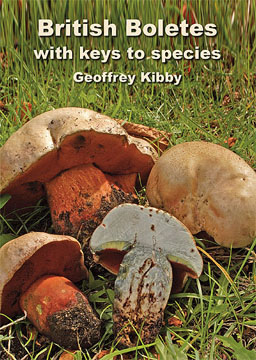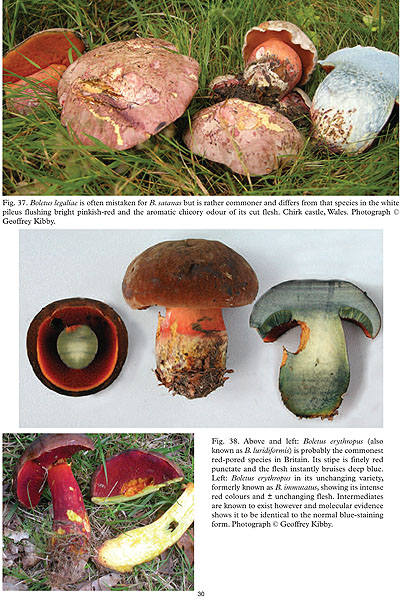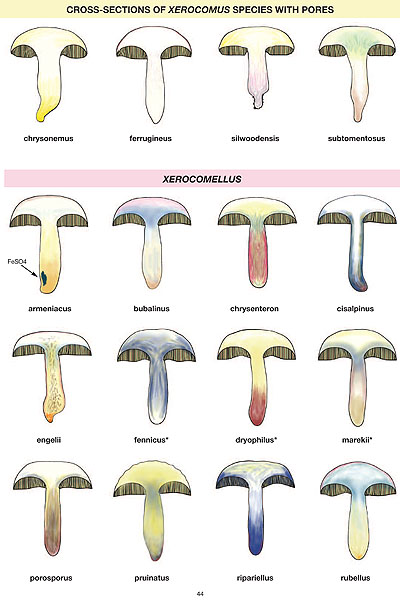New British bolete book
In the introduction to his “The genus Xerocomus” the boletologist Alan Hills wrote “If you want a key written, ask Geoffrey”. I can add nothing to his statement that will better describe Geoffrey’s new book on the British boletes that was just presented to the mycological community.

There is hardly any need to present the author. Geoffrey Kibby is Senior Editor of the journal Field Mycology and most of the readers possibly have enjoyed already his mycological papers or his monograph “British species of the genus Russula” (more details about this book here). Apart from that Geoffrey is a nature photographer and artist who has contributed illustrations to many books and articles.
“British boletes” is a marvelous edition that is simply not to be missed by any mycologist. It is printed on high-quality sturdy A4-sized paper that ensures it will not wear out easily even if you are often taking it with you in the field. In addition the wire binding is excellent finishing that lets the book open flat.
Yet from the same beginning I would like to say – do not get confused by the word “British”, because the book actually presents the vast majority of the known European boletes, except very few species, so it is suitable to be used in most realms in Europe. I also believe that this decision will greatly help the British mycological community in cases, where new country records might be involved, that may otherwise go unnoticed. The readers will easily decide if I am right about this, seeing the new British record Boletus rhodoxanthus and the comments for Boletus luteocupreus.
I am truly amazed by enormous amount of information that is fitted in the book, keeping the text perfectly readable without glasses at the same time. First of all I want to mention the excellent introductory chapters that lead the reader through all the important macroscopic and microscopic features of the boletes, so easily explained and so beautifully illustrated, that even people that have never tackled boletes before will have no problem understanding them.

Reading further on, I very much appreciated the synopsis of the genera. As we all know, bolete systematics has become immensely difficult these days and the constant splitting and lumping sometimes may really puzzle even professional mycologists if they are not especially dealing with this group. I strongly believe that having this book, the reader will no longer suffer with the frequent name changes so generously produced by the modern systematics. Note however, that the author meanwhile takes full advantage of the results of the modern methods of molecular research and keeps the book perfectly up to date.
As the second part of the title suggests, “British boletes” provide keys for recognizing the genera and species. This is the first bolete book, known to me that combines the synoptic type of keys (that we all know very well from Geoffrey’s other work “Leccinum revisited”) together with the traditional dichotomous keys. I know there will be people having hesitation about the dichotomous keys, but I will assure them that all the keys in “British boletes” are straightforward and work very well.

Not only keys are included in the book, but informative descriptions and remarks on all the species tackled. These are also excellent and help the reader to reach a conclusion when trying to determine bolete collections.
The reader will excuse me, but I decided not to count the illustrations in the book, there are too many of them. I will just say that the book is more than amply illustrated and provides spectacular photographs or original paintings of virtually every British species and of most of the included extralimital boletes. There are excellent photographs for some recently described or ill-illustrated species. I also very much appreciate the comparative painting of the xerocomoid boletes, which is certainly unique and helps very much for the understanding of this very difficult group.

Finally, I don’t really like repeating myself but this time I will – do not miss this precious bolete book. It is certainly worth the price, which by the way is more than reasonable.
The book is available from our Bookstore
Readers may further contact Geoffrey Kibby by e-mail (fieldmycol@yahoo.co.uk).
Below is list of the genera and species treated and full bibliographic reference.
Aureoboletus: A. gentilis
Boletus: B. aereus, B. appendiculatus, B. badius, B. betulicola, B. calopus, B. comptus, B. depilatus, B. dupainii, B. edulis, B. erythropus, B. fechtneri, B. fragrans, B. impolitus, B. kluzakii, B. legaliae, B. lupinus, B. luridus, B. luteocupreus, B. moravicus, B. pinophilus, B. pinophilus, B. poikilochromus, B. pseudoregius, B. pseudosulphureus, B. pulverulentus, B. queletii, B. radicans, B. regius, B. reticulatus, B. rhodopurpureus, B. rhodoxanthus, B. satanas, B. speciosus, B. spretus, B. subappendiculatus, B. torosus, B. xanthocyaneus.
Buchwaldoboletus B. lignicola, B. sphaerocephalus
Chalciporus: C. amarellus, C. hypochryseus, C. piperatus, C. rubinus
Gyrodon: G. lividus
Gyroporus: G. castaneus, G. cyanescens
Leccinum: L. albostipitatum, L. atrostipitatum, L. aurantiacum, L. crocipodium, L. cyaneobasileucum, L. duriusculum, L. fuscoalbum, L. holopus, L. melaneum, L. piceinum, L. pseudoscabrum, L. rotundifoliae, L. scabrum, L. schistophilum, L. variicolor, L. versipelle, L. vulpinum
Porphyrellus: P. porphyrosporus
Strobilomyces: S. strobilaceus
Suillus: S. bovinus, S. bresadolae var. flavogriseus, S. cavipes, S. collinitus, S. flavidus, S. granulatus, S. grevillei var. grevillei, S. grevillei var. clintonianus, S. lakei, S. luteus, S. placidus, S. tridentinus, S. variegatus, S. viscidus
Tylopilus: T. felleus
Xanthoconium: X. separans
Xerocomoid boletes:
Pseudoboletus: P. parasiticus
Xerocomus: X. chrysonemus, X. ferrugineus, X. pelletieri, X. silwoodensis, X. subtomentosus
Xerocomellus: X. armeniacus, X. bubalinus, X. chysenteron, X. cisalpinus, X. engelii, X. fennicus, X. guidonis, X. marekii, X. porosporus, X. pruinatus, X. ripariellus, X. rubellus
Bibliographic information:
Kibby, G. 2011. British boletes with keys to species. Published by the author, London.